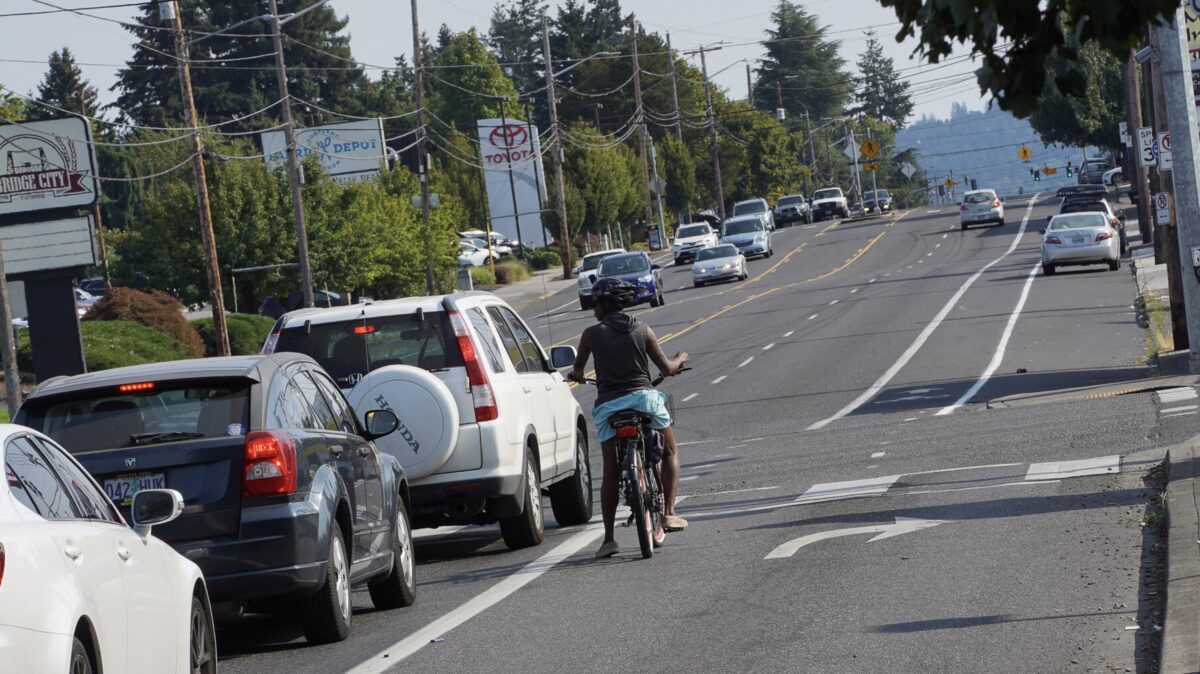
The Portland Bureau of Transportation released their annual deadly traffic crash report on Monday. According to their tally, 63 people died while using Portland roads in 2022 — equal to the 2021 amount. While the overall number is flat, 63 deaths is an 80% jump from the 35 total deaths Portland had in 2018 and it continues an extremely troubling rise in pedestrian fatalities that underscores how dangerous our streets have become and undermines our stated commitments to get serious about it.
The BikePortland tally is even worse. By cross-referencing PBOT’s list and a list provided to us by the Portland Police Bureau, we counted 70 people who died on our streets last year (down from 73 in 2021).
Here are their names:
(Source: BikePortland – Note: Seven deaths not included on the city’s tally are in blue. They include three suicides, two homicides, one MAX collision, and one unknown cause. I include these deaths because they illustrate the imminent threat posed by our system that’s dominated by large, deadly vehicles and people who can too easily abuse them. Vulnerable road users are in green.)
Think about all those people for a moment. Not just who they were, but how many names are on that list. In 2008 — which happened to be the year we became the first large city in America to earn a “Platinum” designation from the League of American Bicyclists — we had 20 total traffic fatalities (with five pedestrian fatalities). In 2022, there were 31 people killed while walking alone.
When Portland leaders unanimously adopted our Vision Zero plan in 2015, they committed to the elimination of all traffic deaths by 2025. That leaves us less than three years to take back our streets and dramatically shift this trend. In fact, if you listen to the Portland city commissioner currently in charge of PBOT, Mingus Mapps, we have only two years left. That’s because he thinks we can only reduce fatalities by 10% this year. Asked about Vision Zero on the City Cast PDX podcast last week Mapps said, “Vision Zero is alive and well. Obviously, in many ways. It’s aspirational… It’s going to take us a while to get to zero. I think we could bring that down by 10% this year through investments and better infrastructure, and the bringing back some enforcement.”
The year 2025 was nowhere to be found in PBOT’s press release yesterday. Instead of a clear-eyed embrace of the challenge and an acknowledgment that we are not meeting the moment, their statement read: PBOT urges the public to slow down, as speed, impairment keep pedestrian deaths at historic high level in Portland, across U.S. in 2022.
“This is a PR masterpiece that makes me disappointed and sad,” wrote local traffic safety advocate Scott Kocher in an email with the press release he forwarded to me yesterday.
The Street Trust Executive Director Sarah Iannarone said in a statement yesterday that, “Telling people to ‘slow down,’ or calling for more policing when the PPB is decrying staffing shortages simply won’t work. We need an innovative, intergovernmental, public health-informed approach if we’re going to reverse this epidemic across our region and state.”
I realize PBOT is doing a lot of good and important work around Vision Zero and this statement and report are just a relatively small piece of it. But given all the headlines this receives, it’s an important opportunity to set course correct, lay out a vision, and set the right tone. Eight years into our Vision Zero initiative we deserve a candid and serious assessment of the problem and a bold plan to solve it. We are far beyond the point of making polite requests or excuses; but that seems to be a big part of the strategy we’ve chosen.
In their 2020 report, PBOT said the 54 people who were killed in traffic (then the highest total since 1996) was “unusual and tragic.” In news interviews and official statements, PBOT urged us to not be alarmed because one year doesn’t make a trend. Then in 2021, PBOT said homeless individuals, the Covid-19 pandemic, “and its tremendous impact on American life,” were contributing factors in the (record) 63 traffic deaths. For 2022 we see a new boogeyman: darkness. Light conditions aren’t mentioned in the previous two reports, but in this most recent one PBOT says, “74% of all traffic deaths occurred in darker conditions… Of pedestrian deaths, 93% occurred in darker conditions…”
Here are some other key takeaways from the latest report:
- 21 deaths occurred on state-owned streets (compared to 32 in 2021 and 20 in 2020)
- 67% of all deaths were in areas that score high on PBOT’s equity matrix for low-incomes and high rates of residents that identify as people of color (compared to 76% in 2021 and 57% in 2020)
- Houseless people made up 19% of traffic deaths in 2022 (compared to 33% in 2021)
- 17 people died in hit-and-run crashes in 2022 (compared to 14 in 2021 and 7 in 2020)
PBOT says another big part of the problem are people who drive too fast and/or drive under the influence of drugs and/or alcohol (with many of those hit-and-runs by impaired drivers). This problem of general lawlessness from more drivers than ever has come under sharper focus with new reporting out this week from The Oregonian that details how the Portland Police Bureau have “failed” to investigate and “alarming number” DUII cases, thus making the cases hard and/or impossible for the District Attorney’s office to prosecute.
A memo obtained by The Oregonian shows that over a two-month span in 2021, PPB did not perform necessary blood draws or breath tests on 22% of people they pulled over for DUIIs. Of the 141 DUII arrests by five policing agencies who patrol the metro area, 25 of them were not fully investigated — and 24 of those were by the PPB.
This story should alarm Commissioner Mapps, who has said he wants to fund more police officers for traffic enforcement and has mentioned his concern about a lack of DUI arrests in both interviews I’ve done with him. Just last week he told me, “I would like drunk drivers to be pulled over and taken off the streets.” Asked about The Oregonian story today, Commissioner Mapps said via email, “There have been breakdowns in every aspect of our public safety and criminal justice system over the last several years. As PBOT Commissioner, my highest priority is public safety on our streets, sidewalks, and transit system. I cannot do this alone; I will need the partnership of the police and the district attorney’s office to intervene in impaired driving and hold people accountable under our laws.”
Regardless of what anyone says or promises, the facts are clear: Our increasingly lawless streets, feckless and disjointed leadership, lack of progress on enforcement, and outdated road designs are no match for the scourge of dangerous streets and irresponsible people who use them.
— Download a PDF of the report here.

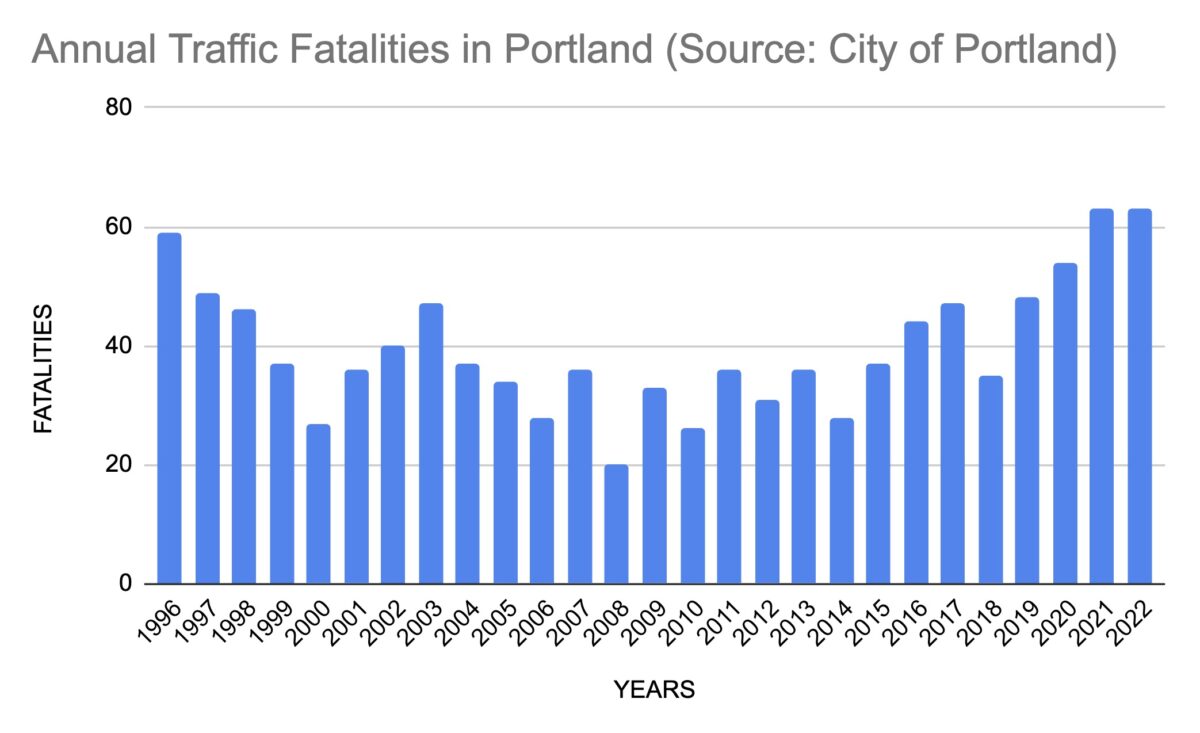
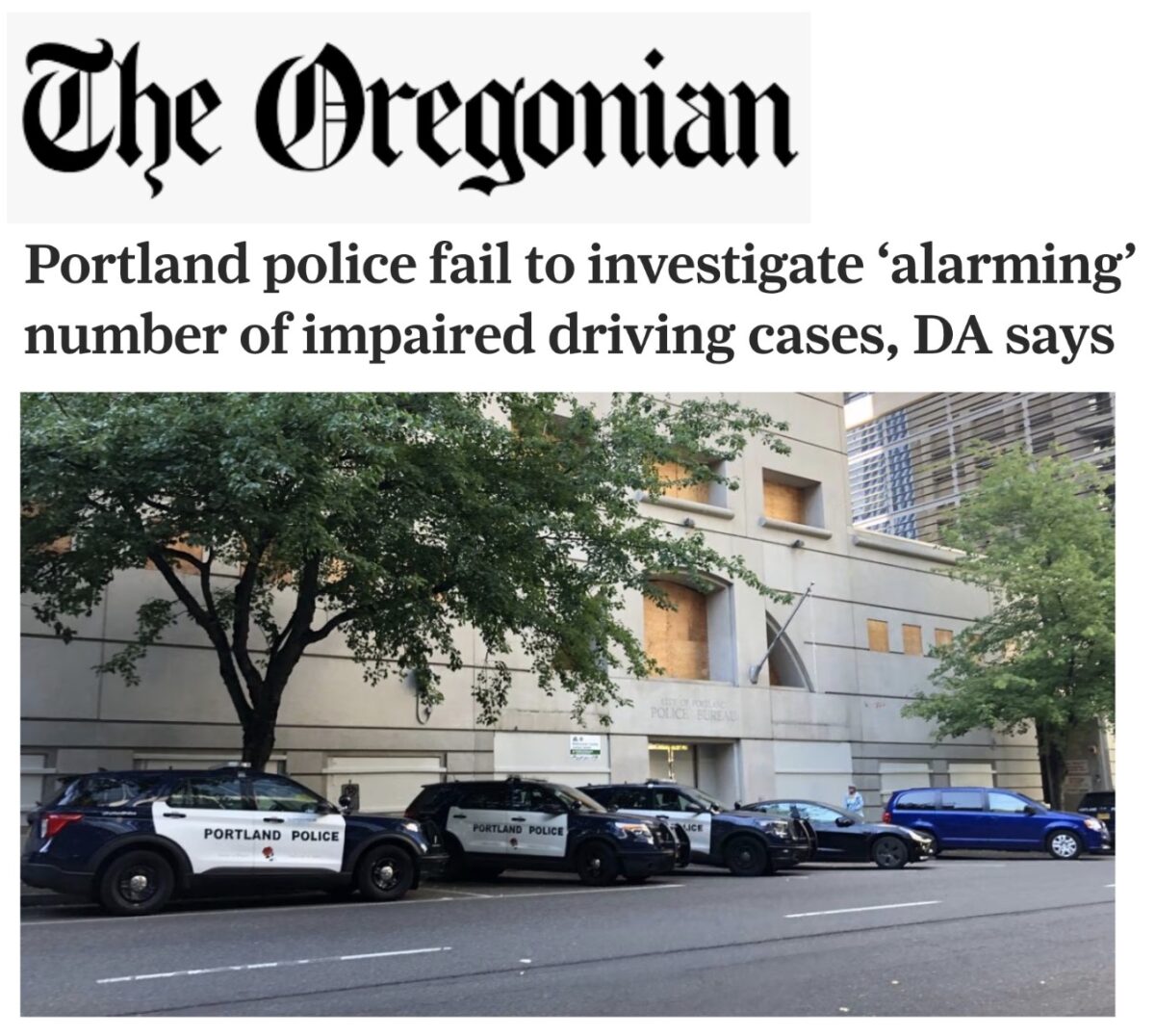
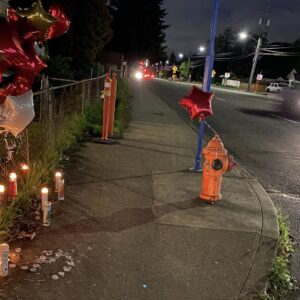
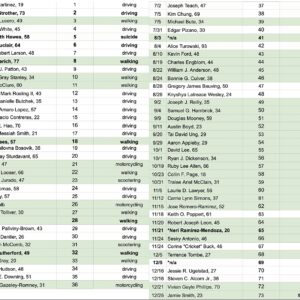


Thanks for reading.
BikePortland has served this community with independent community journalism since 2005. We rely on subscriptions from readers like you to survive. Your financial support is vital in keeping this valuable resource alive and well.
Please subscribe today to strengthen and expand our work.
Per Vision Zero, is there a similar list of crashes that resulted in serious life-changing injuries?
PBOT hasn’t enacted Vision Zero in any way, shape, or form. They just appropriated the name.
If we had Visision Zero, we would have had 70 crash investigations and 70 rapid safety improvements.
I count zero. Maybe that’s the vision?
Yep – Vision Zero is Performative Portland at its best.
New motto: “Portland: The city that talks about stuff.”
Yes. More of that, but: It’s sad to say that often the safety improvements we see are placed after a tragic death. How many times have we all said to ourselves “that spot is so sketchy, can’t go there” only to hear later that a person died. It is not a mystery that some designs are traps for people outside cars but first somebody has to die and then it can be fixed?
If investigation shows a problem in one place we have to follow up all over town.
It’s insanely tone-deaf for PBOT to mention “darkness”, just quintessential victim blaming. There has not been a significant change in the street lighting situation in Portland since 2008 – it’s banal to even suggest that somehow that is responsible for a 400% increase in traffic deaths in 15 years.
People are dying from their inaction, and they have the gall to say “oh well it was dark out, they should have worn brighter clothing”. Shameful.
the other thing I thought of when they singled darkness out was how — making sure streets are well-lit is literally part of their job!
There were 7 large overhead street lights that were non functional at the Naito/Steel bridge. It took repeated reporting, an email to Commissioner Mapps and 6 months for PBOT to repair them! The road/bike path is now lit, but they still have not fixed the light under the viaduct, so it is pretty dark to bike/walk there.
I think this could be strategic, as documenting contributing crash factors like poor and missing lighting is an important step in making those investments eligible for grant funding (particularly anything federal and tied to safe streets work). This is very true of arterials in East Portland that only have lighting on one side (like 122nd) – and where PBOT is going after major funds to rebuild corridor.
interesting point. Thanks for sharing. Makes sense, but negative impact of that framing should be considered.
Has anyone quantified the effects of the city-wide switch to LED street lights? I thought it might help, but not sure anywhere has had them long enough to know?
It also points out the continuing disfunction of our City that one bureau points out darkness as a contributing safety factor (not saying this is ok, but they said it) while another is concurrently removing lighting from multiple City parks.
Dan Ryan is Parks commissioner. His office number:
503-823-3589
His email:
CommissionerRyanOffice@portlandoregon.gov
It’s Rubio now.
what has Rubio accomplished, honestly? She canceled Friend of Trees to help an employee steer money to another group she is close with, went to Denmark for a climate change conference with her whole staff – at taxpayer expense and burning fossil fuels. She has never seen a virtue signaling document she couldn’t sign. The worst one was about letting homeless people camp next to insanely dangerous roads to show how pro homeless she is. Nevermind a vast vast majority of the pedestrian deaths are of poor homeless people. Sadly we keep voting for people who tout their progressiveness, but it is all lip service. Eudaly was an incredibly incompetent and spiteful one, Rubio is terrible, and Vega wants to give 60k per homeless to find a place for them. Well, rent is not 5k/month!
Anyways, Eudaly and Hardesty also came from a place of sticking it to the drivers, instead of doing what would be the best thing for the city and we have our issues. Some of the streets are so hard to navigate with all the things they implemented. I bet that doesn’t help either.
Comment of the Week
I would fire every one of the PBOT higher ups if I could. There has got to be very few examples of this level of incompetence, ignorance and disastrous results. They try to appease the most radical car hating people, but it makes things far worse than if they actually cared and did common sense stuff.
I, too, was extremely discouraged by PBOT/Mapps reminder to drivers to slow down. That’s like telling the inhabitants of a house that’s on fire to be careful with matches. Where’s the sense of urgency? The list of dead is long, and the list of lives forever changed by reckless, inattentive, dangerous drivers is far longer. The great majority of these deaths are the result of excessive speed on a relatively small number of roadways. One solution that wouldn’t take until 2025 and would drastically cut the death rate – install speed bumps and/or bollards right down the middle of the high crash corridors. When people are being killed on stroads with 30 MPH signs that were clearly designed for much higher speeds, it’s time to re-engineer those stroads to force people to drive slower and pay more attention.
I’d be all for PBOT just piling boulders down the middle of the more dangerous roads. They’d be cheap enough. Maybe we paint them yellow if the budget allows? Drive slower so you don’t crash into them!
How is wht Mapps says any worse than what Eudaly and Hardesty have done though? And sure, some bumps are fine, but I think the biggest issue is lack of police and enforcement, and horrible measure 110 bringing a ton of crime and drug addiction. And speed bumps will just push things to the side streets. We need to bring back the lanes they took away. If the traffic is flowing, it actually is better safety wise. Instead we removed lanes from the busiest streets so people use the side streets, we removed police, and enabled criminals. And making signs and streets more and more complex can’t be helpful, can it?
Sadly a lot of people who are bicyclists like to make it harder for drivers not because it is the better idea but because let’s face it, many do not like drivers. But it always backfires. Unless we bring in alternatives, people will keep driving, and unless we bring in enforcement, people will drive lawless.
Add to that the horrible traffic ideas of PBOT, and let’s hurt the other side mentality, things get worse.
Like it or not, we will have cars for a long time. This city really needs to create alternatives so we can get people off the cars. But we also need to make traffic easier to navigate. Like what the hell is going on with NE 53rd turning north bound to it from Glisan? Two lanes then to 1.5 lanes then a ginormous cocnrete barrier. Or Morrison right before MLK – tons of traffic changes, cars parked in middle of the street, then a weird right turn etc.
It is so disingenuous for PBOT to ask people to slow down, but repeatedly provide infrastructure to speed people up! Look at Greeley where 2 or 3 people were killed when someone smashed into their minivan during the design phase! Despite knowing that the average speed was over 55 mph in each direction, PBOT refused to address high speeds with their design, widening the lanes to 13′ to accommodate speeders! Or PBOT’s terrible design at NE 7th/Tillamook that removed a tree and put a lane in a curb extension for pedestrians to open the road up for driving- and on a road where speeding is already a problem.
Slow down is such a half-hearted request! How about don’t drive? Take a bike or transit, walk or carpool.
My nominee for COTW.
Two people almost hit me today on my 45 minute ride home from the dentist. The first was easy to avoid as I saw that they didn’t look in my direction as they were preparing to roll their stop sign so I just slowed down. They checked in my direction again as I came to a stop about three feet from their driver door.
The second was much less in my control. That driver passed me as I was about to make a left so at the intersection which is a traffic violation and quite dangerous. The really bad part was they left me less than a foot of space and since I was going uphill and they startled me, their car being electric, I swerved slightly. I was signaling as they begun to pass so when I swerved my front wheel came within inches of their rear bumper. Both drivers saved zero seconds on their commute.
The other piece not mentioned in this article is the State’s responsibility in all this mess. Even if PPB were doing their jobs the penalties for traffic violations are so lenient that they do almost nothing to discourage dangerous driving. The state needs to change the law to make it harder to get and keep your license. A point system that revokes your license would be a great change. Someone one speeding ticket away from losing their license is certainly going to consider driving more carefully than someone who might get a $165 fine.
Wait, there are no license points in Oregon? I’ve lived here for 25 years and swear there was one! Yes we need stiffer penalties.
Despite growing risks, I choose streets far more than I used to due to the condition of multi-use paths, where we have also failed. If streets get too risky and paths don’t improve, I don’t know where I go. I already ride fewer places than I used to, which takes a lot of the joy out of cycling.
Well Jonathan still won’t publish many comments that don’t align with his political views (pro Joanne Hardesty stuff) but did you see he used “lawless” to refer to Portland? About 3 years too late but glad you’re finally catching up with the reality on our streets Mr Maus!
This isn’t true. Almost all my comments get published, and I doubt JM agrees with any of my opinions.
That doesn’t mean he doesn’t censor many posts. Did you see he used lawless? He may be agreeing with you more than he used to.
As I recall, Portland’s infrastructure in 2008 was not safer than ours today. Drivers were no better trained. I would guess that there were more traffic enforcement actions taking by Portland Police in 2008 than 2022.
There are clearly forces at play here that go beyond what mere local policymakers can do to bring them down to 2008 levels again.
The number of people experiencing homelessness who are struck and killed by drivers while walking or rolling is also notable in the new data: Down from 70% of pedestrian fatalities in 2021 to 36% in 2022. The Oregon Walks data for 2017-2019 was 24%.
The 70% statistic for 2021 was Mayor Wheeler’s justification for emergency sweeps along roadways last year. Did the sweeps “work”? Was the 70% number *way* wrong? Is there just that much year-to-year variability? If we can ever get the police reports we can possibly answer those questions and more.
Regardless of the exact percentage, allowing and enabling unsanctioned street camping is clearly dangerous (and inhumane).
Also, how many of the drivers killing these people are homeless? Having had my car stolen twice by joyriders and just paying attention to the news without a biased lens, many, many people driving stolen cars around these days come from the drug using community, such as it is.
Only 4 cyclists on the list, that should be of some note.
Plus 11 “motorcyling” which in police parlance some of those could be e-bikes.
I was looking through the reports for the motorcycling activity to see if your comment had merit.
“Plus 11 “motorcycling” which in police parlance some of those could be e-bikes”.
But I did find one death that fits the bill. #24 5/4 Shane Johnson. The activity was listed as Motorcycling, but the headline of the report was
“Bicyclist Dies from Injuries Sustained in Southeast Portland Crash”.
The report then stated he was struck by a vehicle while riding an electric bicycle. The report also states
“MCT investigators learned from witnesses and nearby videos that Johnson entered the roadway unexpectedly for an unknown reason and believe the driver had no time to adjust their course of travel”.
So, by now many of you are thinking, great another bicyclist struck and killed by a driver in a big metal box not paying attention. If he was riding an e-bike as defined by Oregon State Law, then indeed he was a bicyclist. If he was on an e-bike capable of higher speeds (models are available with speeds greater than 60mph) than he becomes a motorcyclist and should have a driver’s license with a motorcycle endorsement. This is just speculation on my part. If the e-bike rider was coming from a side street and his speed was 20 mph or less A: the e-bike should have enough time and braking to stop before entering the crossroad. B: the driver sees the cyclist and figures the e-bike will arrive at the intersection after they do. Now if the e-bike is traveling at higher speeds, A: the driver’s calculation of when the bike arrives at the intersection will be wrong. B: the rider’s ability to stop in time is limited. When I googled the fastest e-bikes I was very skeptical that the brakes could stop the bike running at high speeds.
As the adoption of e-bikes increases Portland could see more reports like this. Actually, after reading several the reports, it is evident that crashes need to be investigated thoroughly and detailed reports need to be generated. Once that’s done then PBOT and ODOT need to review the reports and determine if infrastructure could have prevented the crash. I think the answers lie in more enforcement, proper infrastructure, and better license requirements. But until we know the root causes of all crashes were only guessing at what needs to be done.
Take your ray of sunshine elsewhere.
The two big differences between 2022 and 2008:
The number of cycling deaths – tragic though they are – is about the same, though probably higher in miles traveled since fewer people are cycling now, which is also a scandal.
Some more factors:
(3) larger, heavier and more powerful vehicles.
(4) More distraction through electronics
Not Just Bikes just realized a good video on trucks and SUVs, how they obliterate city’s (feeble) attempts to make streets safer, and how city’s need to respond to this thread.
The move towards even more heavy, fast accelerating EVs will only further exacerbate this problem, as the Monday highlights pointed out.
Great points. Recently I stood near one of those discontinuous speed bumps (fire-truck speed bumps?) on SW Shattuck and watched the trucks and SUVs speed over them (and through them). No need to slow down at all!
I hadn’t realized that “road dominance” is a big appeal of these vehicles until I saw how they so easily defeat PBOT’s performative speed-limiting methods.
So when is the mayor going to demand that ppb start traffic enforcement again? Isn’t 3 years long enough? How many more people need to die on our streets? Why aren’t they giving traffic deaths the same urgency and resources as gun deaths?
There are people (some on this list) who make a conscious practice of driving within the bounds of familiar traffic laws and safe practices. I think there’s still potential benefit in communication. If the subset of people who are able to care about traffic deaths drive within speed limits, observe crosswalks, and approach traffic signals with normal caution it would be more difficult for scofflaws to carry on.
I still remember losing 5 points on my driving test when I accelerated slightly to pass through the green signal at a familiar intersection. There was no opposing traffic and no yellow light. I think the Oregon process for receiving and maintaining a driver’s license is extremely lax.
Drive for your neighbor, and their children, and their aging parents.
They (and you) are preaching to the converted. We need somehow to reach the people outside of the Church of Safe Road Use.
Remember, it only takes one leader to make a dramatic change in modal share as well as crashes, one leader that prioritizes a physically separated bike network for a few years.
If you read the comments on declining bike counts, you’ll see that the issues are much bigger than infrastructure. And infrastructure may not even part of the story at all.
One fact to note is that 21 people died while driving in / being driven by a vehicle, which is more than the total number of fatalities in 2008 (which was 20).
Our roads have become less safe for everyone, especially for people walking, but also for people driving. I emphasize this to all my concerned friends who ask me about my dangerous habit of using a bike around town. I actually feel safer biking on neighborhood streets these days than driving on freeways and arterials.
That our streets have become less safer for everyone is also a powerful message because most people in Portland drive. So everyone should be concerned about this trend, for very selfish reasons, and everyone should urge the city to make our streets safer. We are all vulnerable road users, and we are made vulnerable because the city allows dangerous vehicles to be misused on our streets.
Vision Zero, what a scam…And thanks to Hardesty, we have no traffic police. Also thanks to radicals, people were allowed to drive without license plates. Also thanks to Hardesty and Eudaly, lanes are being taken away from busy streets which make people rush more, use side streets etc. And again thanks to radical left, we have drug addicts plenty, criminals being released right and left, and more crime. I am all for progressive ideas, but all we get is radicals who are incompetent and have no connection to reality. I am done voting for progressives in Portland, they are not really progressives, and they screwed up everything they said they would make it better. Rental market, crime, drug addiction, homelessness, traffic, bicycle ridership, the environment. Every one of them has been failed in Portland.